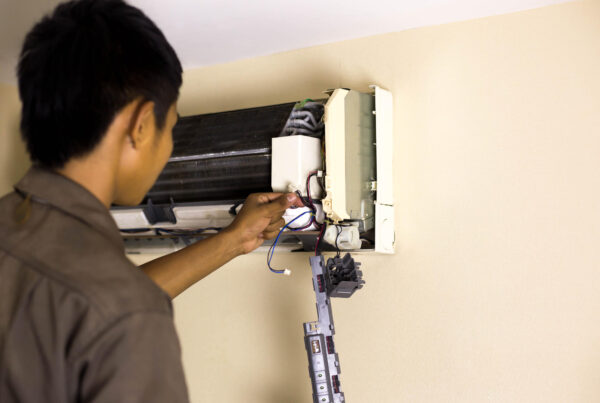Are you feeling off at home lately? Do you have a persistent sore throat or fatigue but only when you’re at home? There could be a problem with your home’s indoor air quality or IAQ.
Most Americans spend 90% of their time indoors where some pollutants are two to five times more concentrated than outside. If that indoor air isn’t clean, you and your family could experience negative effects. Thankfully, there are ways to improve your home’s air quality.
Indoor air quality testing can help you determine if your home’s air is clear of harmful pollutants. Keep reading to discover the benefits of indoor air quality testing.
What Is Indoor Air Quality Testing?
IAQ testing reads air samples from different parts of your home. An IAQ report will tell you if there are concerns with your home’s air quality.
It’s best to contact a professional to perform an IAQ test. Home test kits on the market today are not as accurate.
A professional service can test to find what’s in your air and help you find the source(s). Professionals can help you come up with a plan to improve indoor air quality in your home.
Why Test Indoor Air Quality?
According to Baylor University Associate Professor of Allergy and Immunology, Dr. Stuart Abramson, Houstonians’ top allergens are found indoors. These allergies can be compounded by air pollution and outdoor allergens, like pollen.
Of course, there’s nothing you can do about that yellow dust found around the area every year. You can control the air quality in your home.
Poor IAQ can cause chronic coughing, runny nose, watery eyes, scratchy throat, headaches, or wheezing. It can also worsen conditions like asthma, which is serious if not controlled.
If you or a household member has worsening symptoms inside your home, the IAQ could be the culprit. Improving your family’s health is one of the main benefits of indoor air quality testing.
What Could Indoor Air Quality Testing Find?
It’s never pleasant to think about harmful particles floating around your home, but it happens. Here are some of the most common household offenders affecting IAQ. Testing indoor air quality can make you aware of potentially harmful substances in your home.
Combustion Pollutants
Carbon Monoxide and Nitrogen Dioxide are two common indoor combustion pollutants. Carbon Monoxide causes dizziness, nausea, fatigue, headaches, and even death. Nitrogen Dioxide causes increases in respiratory infections, itchy eyes, and throat, and decreased lung function.
Both of these combustion pollutants enter your home’s air through unvented gas heaters, indoor furnaces, leaking chimneys, has stoves or fireplaces, and tobacco products.
To avoid excess combustion pollutants in your indoor air, vent appliances outside when possible. Have your furnace, fireplace, and heaters regularly serviced by professionals. Make sure fuel-burning heaters or products are only used in well-ventilated areas.
Make sure you have working carbon monoxide detectors in your home at all times. Change batteries and test carbon monoxide and smoke detectors twice a year.
Mold
Molds indoors are almost always caused by an unwanted (or unknown) moisture problem. When unattended moisture issues continue, mold growth will likely follow. Molds are living substances that can multiply.
Molds are common allergy triggers. Sometimes molds are visible and can be cleaned with proper caution. If you suspect mold growth somewhere in your home, it’s best to contact a professional.
Trying to clean large-scale mold problems on your own could be dangerous. Always consult a professional to remove wide-spread molds.
VOCs
Short for Volatile Organic Compounds, VOCs, enter your home when certain substances are used or even stored. VOCs are harmful chemicals in paint, glue, wax, degreasers, disinfectants, and thousands of other products.
VOCs are released into the air when products are used or stored. They can also enter your home’s indoor air over time through items that sit in your home, like paint or plastics.
According to the CDC, VOCs are two to five times more concentrated indoors than outdoors. Always open windows and ventilated areas where you’re painting or using harsh chemicals. This decreases the amount of VOCs in your home.
Radon
Found in soil, Radon is a radioactive gas. It can seep up into your home through cracks and gaps in the foundation, flooring, or cavities inside your house.
You won’t be able to see or smell radon, but it’s the second leading cause of lung cancer behind smoking. Radon exposure is responsible for an estimated 20,000 lung cancer deaths annually.
Contact a professional to detect Radon in your home. If Radon is found, you’ll be able to install a mitigation system to decrease Radon to safe levels. This may come at a cost to you, but it’s well worth it to keep those in your household healthy.
Dust and Dust Mites
It seems dust collects just as quickly as we take care of it. Bits of food, fibers, insects, skin, and soil create dust in our homes. Unfortunately, dust is responsible for one of the most common indoor allergens.
Dust mites are tiny organisms that live off the dust in your home. Their droppings trigger asthma and allergy symptoms. Watch out for carpets, bathroom rugs, or anywhere human dander and high humidity exist.
You can decrease the number of dust mites in your home by washing bedding weekly in hot water. Eliminating carpets or keeping them clean will also decrease the number of dust mite housemates.
Animal Dander
There are several ways your fur babies could be causing IAQ issues in your home. Contrary to popular belief those allergic to animals aren’t allergic to hair or fur. Dander is a tiny protein found in animal saliva.
Dander is sticky and light so it travels very easily. Even if you don’t have a pet, your home could still have animal dander brought in by household members.
Pets can also carry outdoor allergies in your home. When Fido goes out to do his business, he rolls around in grass, leaves, or other substances and carries them into your home through fur and paws.
By regularly cleaning your home and pets, you can reduce the amount of pet dander in your house.
Call Guy’s for Indoor Air Quality Testing
Poor IAQ can lead to health problems. Undetected combustion pollutants can be fatal. Invisible molds, dander, and dust mites can trigger respiratory issues and other serious health problems. It’s best to call a professional who knows how to test indoor air quality.
Don’t wait to have indoor air quality testing done in your home. The professionals at Guy’s Air Conditioning and Heating can help you. We proudly serve the greater Houston area for over 35 years. Take advantage of our 24-hour emergency services, financing options, and quality products.
Find the location closest to you and contact us today.





